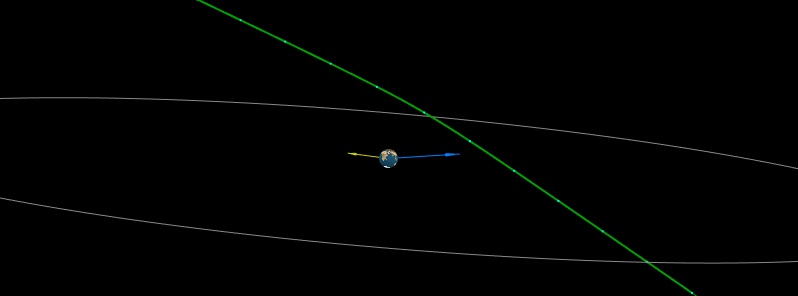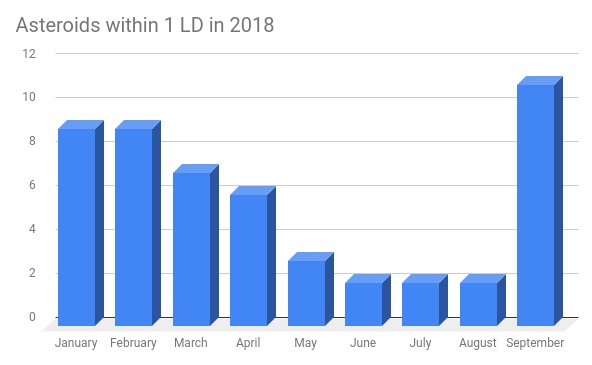Asteroids 2018 SM and SD2 flew past Earth at 0.11 and 0.25 LD

Two newly discovered asteroids – 2018 SM and SD2 – flew past Earth within 1 lunar distance on September 15 and 25, 2018. Asteroid SD2 is now the 51st known asteroid to flyby Earth within 1 lunar distance since the start of the year and 11th this month, making September the month with most <1 LD flybys so far this year.
Asteroid 2018 SM was first observed at Catalina Sky Survey on September 16, one day after it made its close approach to Earth. This object belongs to the Apollo group of asteroids and has an estimated diameter between 3.5 and 7.9 m (11.5 – 25.9 feet).
It flew past Earth at a speed (relative to the Earth) of 11.08 km/s at 22:29 UTC on September 15 at a distance of 0.11 LD / 0.00028 AU (41 887 km / 26 027 miles).
[ Ephemeris | Orbit Diagram | Orbital Elements | Physical Parameters | Close-Approach Data ]
Asteroid 2018 SD2 was first observed at ATLAS-HKO, Haleakala on September 21, 4 days before its close approach. This object belongs to the Aten group of asteroids and has an estimated diameter between 5 and 11 m (16.4 – 36 feet).
It made its close approach to our planet at a speed (relative to the Earth) of 4.14 km/s at 06:07 UTC on September 25 at a distance of 0.23 LD / 0.00059 AU (88 267 km / 54 843 miles).
[ Ephemeris | Orbit Diagram | Orbital Elements | Mission Design | Physical Parameters | Close-Approach Data ]
As already said, this is now the 51st known asteroid to flyby Earth within 1 lunar distance since the start of the year and 11th this month, making September the month with most <1 LD asteroid flybys so far this year.


References
Asteroid 2018 SM at Minor Planet Center; at CNEOS
Asteroid 2018 SD2 at Minor Planet Center; at CNEOS
Featured image: Asteroid 2018 SM geocentric flyby diagram. The green line indicates the object's apparent motion relative to the Earth, and the bright green marks are the object's location at approximately half hour intervals. The Moon's orbit is grey. The blue arrow points in the direction of Earth's motion and the yellow arrow points toward the Sun. Credit: Minor Planet Center

Commenting rules and guidelines
We value the thoughts and opinions of our readers and welcome healthy discussions on our website. In order to maintain a respectful and positive community, we ask that all commenters follow these rules:
We reserve the right to remove any comments that violate these rules. By commenting on our website, you agree to abide by these guidelines. Thank you for helping to create a positive and welcoming environment for all.